What Determinants Will Enhance or Constrain the Spatiality of Agricultural Products with Geographical Indications in Northeast China? An Interpretable Learning Approach
Abstract
:1. Introduction
2. Literature Review
2.1. Do GIAPs Have Development Prospects in Northeast China?
2.2. What Factor Will Enhance or Constrain the Development of GIAPs?
2.3. How to Interpret the Relationship between Factors and the Development of GIAPs?
3. Materials and Methods
3.1. Study Area and Data Source
3.2. Methodology
3.2.1. Machine Learning Model Selection
3.2.2. Model Evaluation
3.2.3. Effect of Variables Evaluation
- (1)
- Ranking variable importance.
- (2)
- Partial Dependence Plot and Individual Conditional Expectation Plot (PDP/ICE).
- (3)
- Shapley Additive Explanation (SHAP) Method.
4. Results
4.1. Spatiotemporal Co-Evolution of GIAPs: From Monocentric to Polycentric
4.2. Interpreting the Effect of Determinants on GIAPs
4.2.1. Quantifying the Importance of Factors
4.2.2. Evaluating the Average and Individual Effect of Factors
4.2.3. Interpreting the Heterogeneous Effect of Factors on Each Sample
5. Discussion
6. Conclusions
Author Contributions
Funding
Data Availability Statement
Acknowledgments
Conflicts of Interest
References
- Liu, Y.; Li, Y. Revitalize the World’s Countryside. Nature 2017, 548, 275–277. [Google Scholar] [CrossRef] [PubMed]
- FAO (Ed.) Leveraging Food Systems for Inclusive Rural Transformation; The State of Food and Agriculture; Food and Agriculture Organization of the United Nations: Rome, Italy, 2017; ISBN 978-92-5-109873-8. [Google Scholar]
- Nizam, D.; Tatari, M.F. Rural Revitalization through Territorial Distinctiveness: The Use of Geographical Indications in Turkey. J. Rural. Stud. 2022, 93, 144–154. [Google Scholar] [CrossRef]
- Vandecandelaere, E.; Arfini, F.; Belletti, G.; Marescotti, A. Linking People, Places and Products: A Guide for Promoting Quality Linked to Geographical Origin and Sustainable Geo-Graphical Indications; FAO: Rome, Italy, 2009; ISBN 978-92-5-106656-0. [Google Scholar]
- Milano, M.Z.; Cazella, A.A. Environmental Effects of Geographical Indications and Their Influential Factors: A Review of the Empirical Evidence. Curr. Res. Environ. Sustain. 2021, 3, 100096. [Google Scholar] [CrossRef]
- Bérard, L.; Marchenay, P. Local Products and Geographical Indications: Taking Account of Local Knowledge and Biodiversity. Int. Soc. Sci. J. 2006, 58, 109–116. [Google Scholar] [CrossRef]
- Vakoufaris, H.; Gocci, A. Geographical Indications and Sustainable Development: An Assessment of Four Categories of Products from the Fruit and Vegetable Sector of the Eu. Food Rev. Int. 2022, 39, 1–14. [Google Scholar] [CrossRef]
- Mesić, Ž.; Božić, M.; Cerjak, M. The Impact of Geographical Indications on the Competitiveness of Traditional Agri-Food Products. J. Cent. Eur. Agric. 2017, 18, 1–14. [Google Scholar] [CrossRef]
- Suh, J.; MacPherson, A. The Impact of Geographical Indication on the Revitalisation of a Regional Economy: A Case Study of ‘Boseong’ Green Tea. Area 2007, 39, 518–527. [Google Scholar] [CrossRef]
- Resano, H.; Sanjuán, A.I.; Albisu, L.M. Consumers’ Response to the EU Quality Policy Allowing for Heterogeneous Preferences. Food Policy 2012, 37, 355–365. [Google Scholar] [CrossRef]
- Deselnicu, O.C.; Costanigro, M.; Souza-Monteiro, D.M.; McFadden, D.T. A Meta-Analysis of Geographical Indication Food Valuation Studies: What Drives the Premium for Origin-Based Labels? J. Agric. Resour. Econ. 2013, 38, 204–219. [Google Scholar]
- Menapace, L.; Moschini, G.C. Strength of Protection for Geographical Indications: Promotion Incentives and Welfare Effects. Am. J. Agric. Econ. 2014, 96, 1030–1048. [Google Scholar] [CrossRef]
- Lamarque, P.; Lambin, E.F. The Effectiveness of Marked-Based Instruments to Foster the Conservation of Extensive Land Use: The Case of Geographical Indications in the French Alps. Land Use Policy 2015, 42, 706–717. [Google Scholar] [CrossRef]
- Belletti, G.; Marescotti, A.; Sanz-Cañada, J.; Vakoufaris, H. Linking Protection of Geographical Indications to the Environment: Evidence from the European Union Olive-Oil Sector. Land Use Policy 2015, 48, 94–106. [Google Scholar] [CrossRef]
- World Trade Organization. Available online: https://www.wto.org/english/tratop_e/trips_e/trips_e.htm (accessed on 17 September 2023).
- Li, L. Research on the Brand Preference Formation Mechanism of the Agricultural Product Geographical Indication: From the Perspective of Geographical Relationship. Ph.D. Dissertation, Huazhong Agricultural University, Wuhan, China, 2022. [Google Scholar]
- García-Hernández, C.; Ruiz-Fernández, J.; Rodríguez-Gutiérrez, F. Geographical Indications in Cheese Mountain Areas: Opportunity or Threat to Landscape and Environmental Conservation? The Case of Cabrales (Spain). Appl. Geogr. 2022, 146, 102753. [Google Scholar] [CrossRef]
- Xian, Y.; Liu, G.; Zhong, L. Will Citrus Geographical Indications Face Different Climate Change Challenges in China? J. Clean. Prod. 2022, 356, 131885. [Google Scholar] [CrossRef]
- Shiu, J.Y.; Liao, S.T.; Tzeng, S.-Y. How Does Online Streaming Reform E-Commerce? An Empirical Assessment of Immersive Experience and Social Interaction in China. Humanit. Soc. Sci. Commun. 2023, 10, 224. [Google Scholar] [CrossRef]
- Tian, H.; Lee, Y. Factors Affecting Continuous Purchase Intention of Fashion Products on Social E-Commerce: SOR Model and the Mediating Effect. Entertain. Comput. 2022, 41, 100474. [Google Scholar] [CrossRef]
- Ministry of Commerce of the People’s Republic of China. Available online: http://ipr.mofcom.gov.cn/hwwq_2/chn_eu_gi/file/EN.pdf (accessed on 17 September 2023).
- European Commission. Available online: https://agriculture.ec.europa.eu/common-agricultural-policy/cap-overview/cmef/products-and-markets/value-production-agricultural-products-and-foodstuffs-wines-aromatised-wines-and-spirits-protected_en (accessed on 17 September 2023).
- Heilongjiang News. Available online: http://epaper.hljnews.cn/hljrb/pc/layout/202305/16/node_01.html (accessed on 17 September 2023).
- AliResearch. Available online: http://www.aliresearch.com/ch/information/informationdetails?articleCode=306957980434305024&type=%E6%96%B0%E9%97%BB (accessed on 17 September 2023).
- Gangjee, D.S. Proving Provenance? Geographical Indications Certification and Its Ambiguities. World Dev. 2017, 98, 12–24. [Google Scholar] [CrossRef]
- Haeck, C.; Meloni, G.; Swinnen, J. The Value of Terroir: A Historical Analysis of the Bordeaux and Champagne Geographical Indications. Appl. Econ. Perspect. Policy 2019, 41, 598–619. [Google Scholar] [CrossRef]
- Liu, J.; Huang, Y.; Wang, Y.; Wu, M. Spatial-temporal Distribution Characteristics and Humanistic Causes of Geographical Indication Agricultural Products in Hunan Province. Econ. Geogr. 2022, 42, 169–176+215. [Google Scholar] [CrossRef]
- Xie, Y.; Wang, C.; Wu, A. Spatiotemporal Evolution and Interactive Effects of Geographical Indication Agricultural Products and Agricultural Economy. Sci. Geogr. Sin. 2022, 42, 1577–1587. [Google Scholar] [CrossRef]
- Parrott, N.; Wilson, N.; Murdoch, J. Spatializing Quality: Regional Protection and the Alternative Geography of Food. Eur. Urban Reg. Stud. 2002, 9, 241–261. [Google Scholar] [CrossRef]
- Cei, L.; Stefani, G.; Defrancesco, E. How Do Local Factors Shape the Regional Adoption of Geographical Indications in Europe? Evidences from France, Italy and Spain. Food Policy 2021, 105, 102170. [Google Scholar] [CrossRef]
- Maró, Z.M.; Balogh, P.; Czine, P.; Török, Á. The Roles of Geographic Indication and Ethnocentrism in the Preferences of Central European Spirit Consumers: The Case of Pálinka. Food Qual. Prefer. 2023, 108, 104878. [Google Scholar] [CrossRef]
- Xiong, Z.; Wu, Q. Research on Financial Support for Industrialization of Geographical Indication Products of Yellow plum Lotus Leaf Tea under the Background of Rural Revitalization. Mod. Bus. 2023, 6, 19–22. [Google Scholar] [CrossRef]
- Wang, H.; Qin, W. Research on the Spatial Distribution and Agglomeration Characteristics of Geographical Indication Products in China. World Reg. Stud. 2023, 32, 157–166. [Google Scholar]
- Wang, J.; Xue, Y.; Wang, P.; Chen, J.; Yao, L. Participation Mode and Production Efficiency Enhancement Mechanism of Geographical Indication Products in Rural Areas: A Meta-Frontier Analysis. Phys. Chem. Earth Parts A/B/C 2021, 121, 102982. [Google Scholar] [CrossRef]
- Yan, Q. Study on Spatio-temporal Soupling between Agricultural Economy Growing and Geographic Indication Products of Agricultural Developing Guangxi. Master’s Dissertation, Nanning Normal University, Nanning, China, 2020. [Google Scholar]
- Crozet, M.; Head, K.; Mayer, T. Quality Sorting and Trade: Firm-Level Evidence for French Wine. Rev. Econ. Stud. 2012, 79, 609–644. [Google Scholar] [CrossRef]
- Qian, W.; Dong, Y. The Promoting Effect of Mutual Recognition of Geographical Indications between China and Europe on China’s Agricultural Exports—A Mechanism Research from a “Dual Circulation” Perspective. J. Int. Trade 2023, 6, 121–138. [Google Scholar] [CrossRef]
- Zhang, W. Business and Service Location Theory. In Economic Geography; Li, X., Ed.; Higher Education Press: Beijing, China, 2006; pp. 94–100. [Google Scholar]
- Guo, J.; Jin, S.; Zhao, J.; Wang, H.; Zhao, F. Has COVID-19 Accelerated the E-Commerce of Agricultural Products? Evidence from Sales Data of E-Stores in China. Food Policy 2022, 112, 102377. [Google Scholar] [CrossRef]
- Ma, W.; Abdulai, A. The Economic Impacts of Agricultural Cooperatives on Smallholder Farmers in Rural China. Agribusiness 2017, 33, 537–551. [Google Scholar] [CrossRef]
- Marcello, D.R.; Felice, A.; Yari, V. Building up Collective Actions to Qualify GIs. Land Use Policy 2017, 66, 340–345. [Google Scholar] [CrossRef]
- Pantera, A.; Burgess, P.J.; Mosquera Losada, R.; Moreno, G.; López-Díaz, M.L. Agroforestry for High Value Tree Systems in Europe. Agroforest Syst. 2018, 92, 945–959. [Google Scholar] [CrossRef]
- Dentoni, D.; Menozzi, D.; Capelli, M.G. Group Heterogeneity and Cooperation on the Geographical Indication Regulation: The Case of the ”Prosciutto Di Parma” Consortium. Food Policy 2012, 37, 207–216. [Google Scholar] [CrossRef]
- Quinones-Ruiz, X.F.; Penker, M.; Belletti, G.; Marescotti, A.; Scaramuzzi, S. Why Early Collective Action Pays off: Evidence from Setting Protected Geographical Indications. Renew. Agric. Food Syst. 2017, 2, 179. [Google Scholar] [CrossRef]
- Nyagaka, D.; Obare, G.; Omiti, J.; Nguyo, W. Technical Efficiency in Resource Use: Evidence from Smallholder Irish Potato Farmers in Nyandarua North District, Kenya. Afr. J. Agric. Res. 2010, 5, 1179–1186. [Google Scholar]
- Hoang, G.; Le, H.T.T.; Nguyen, A.H.; Dao, Q.M.T. The Impact of Geographical Indications on Sustainable Rural Development: A Case Study of the Vietnamese Cao Phong Orange. Sustainability 2020, 12, 4711. [Google Scholar] [CrossRef]
- Liao, Y. The Influence of the Development of Agricultural Products of Geographical Indication on the Farmers’ Income Growth: Spatial Spillover Effect and Regional Heterogeneity. J. Hunan Agric. Univ. 2021, 22, 26–33. [Google Scholar] [CrossRef]
- Wang, H.; Du, G. The Spatial Distribution of Geographical Indications and Agricultural Economic Growth in China. East China Econ. Manag. 2021, 35, 82–90. [Google Scholar] [CrossRef]
- Zhang, H.; Du, Z.; Zhang, S.; Yan, X. Reasearch on Spatial Differentiation of Agricultural Products in Liaoning Province Based on ArcGIS and GD. Chin. J. Agric. Resour. Reg. Plan. 2022, 1, 253–264. [Google Scholar]
- Jato-Espino, D.; Mayor-Vitoria, F. A Statistical and Machine Learning Methodology to Model Rural Depopulation Risk and Explore Its Attenuation through Agricultural Land Use Management. Appl. Geogr. 2023, 152, 102870. [Google Scholar] [CrossRef]
- Zhang, P.; Hu, S.; Li, W.; Zhang, C.; Yang, S.; Qu, S. Modeling Fine-Scale Residential Land Price Distribution: An Experimental Study Using Open Data and Machine Learning. Appl. Geogr. 2021, 129, 102442. [Google Scholar] [CrossRef]
- Alpaydin, E. Adaptive Computation and Machine Learning. In Introduction to Machine Learning; The MIT Press: Cambridge, MA, USA, 2020. [Google Scholar]
- Xu, X.Z.; Xu, Y.; Chen, S.C.; Xu, S.G.; Zhang, H.W. Soil Loss and Conservation in the Black Soil Region of Northeast China: A Retrospective Study. Environ. Sci. 2010, 13, 793–800. [Google Scholar] [CrossRef]
- Li, D.; Yang, Y.; Du, G.; Huang, S. Understanding the Contradiction between Rural Poverty and Rich Cultivated Land Resources: A Case Study of Heilongjiang Province in Northeast China. Land Use Policy 2021, 108, 105673. [Google Scholar] [CrossRef]
- Ma, L.; Zhang, Q.; Wästfelt, A.; Wang, S. Understanding the Spatiality of the Rural Poor’s Livelihoods in Northeast China: Geographical Context, Location and Urban Hierarchy. Appl. Geogr. 2023, 152, 102865. [Google Scholar] [CrossRef]
- Breiman, L. Random Forests. Mach. Learn. 2001, 45, 5–32. [Google Scholar] [CrossRef]
- Li, T.; Zhang, Q.; Peng, Y.; Guan, X.; Li, L.; Mu, J.; Wang, X.; Yin, X.; Wang, Q. Contributions of Various Driving Factors to Air Pollution Events: Interpretability Analysis from Machine Learning Perspective. Environ. Int. 2023, 173, 107861. [Google Scholar] [CrossRef] [PubMed]
- Zhang, Y.-F.; Ren, W.; Wang, W.-L.; Li, N.; Zhang, Y.-X.; Li, X.-M.; Li, W.-H. Interpretable Hardness Prediction of High-Entropy Alloys through Ensemble Learning. J. Alloys Compd. 2023, 945, 169329. [Google Scholar] [CrossRef]
- Mei, L.; Jiang, H. The Spatial Differentiation Process, Factors and Trends of B&B in Beijing Based on Airbnb Data. Econ. Geogr. 2021, 41, 213–222. [Google Scholar] [CrossRef]
- Zhao, Q.; Hastie, T. Causal Interpretations of Black-Box Models. J. Bus. Econ. Stat. 2021, 39, 272–281. [Google Scholar] [CrossRef]
- Li, M.; Yang, Y.; He, Z.; Guo, X.; Zhang, R.; Huang, B. A Wind Speed Forecasting Model Based on Multi-Objective Algorithm and Interpretability Learning. Energy 2023, 269, 126778. [Google Scholar] [CrossRef]
- Lundberg, S.M.; Lee, S.-I. A Unified Approach to Interpreting Model Predictions. In Proceedings of the 31st International Conference on Neural Information Processing Systems, Montreal, QC, Canada, 2–7 November 2018; Curran Associates Inc.: Red Hook, NY, USA, 2017; pp. 4768–4777. [Google Scholar]
- Bogdanovic, B.; Eftimov, T.; Simjanoska, M. In-Depth Insights into Alzheimer’s Disease by Using Explainable Machine Learning Approach. Sci. Rep. 2022, 12, 6508. [Google Scholar] [CrossRef]
- Vandecandelaere, E.; Samper, L.F.; Rey, A.; Daza, A.; Mejía, P.; Tartanac, F.; Vittori, M. The Geographical Indication Pathway to Sustainability: A Framework to Assess and Monitor the Contributions of Geographical Indications to Sustainability through a Participatory Process. Sustainability 2021, 13, 7535. [Google Scholar] [CrossRef]
- Bergleiter, S.; Meisch, S. Certification Standards for Aquaculture Products: Bringing Together the Values of Producers and Consumers in Globalised Organic Food Markets. J. Agric. Environ. Ethics 2015, 28, 553–569. [Google Scholar] [CrossRef]
- Arthur, H.; Thornton, A.; Tranter, P. Private Actors and Food Safety Governance in the Accra City Region: Implications for Local Food Policy. Cities 2022, 131, 104069. [Google Scholar] [CrossRef]
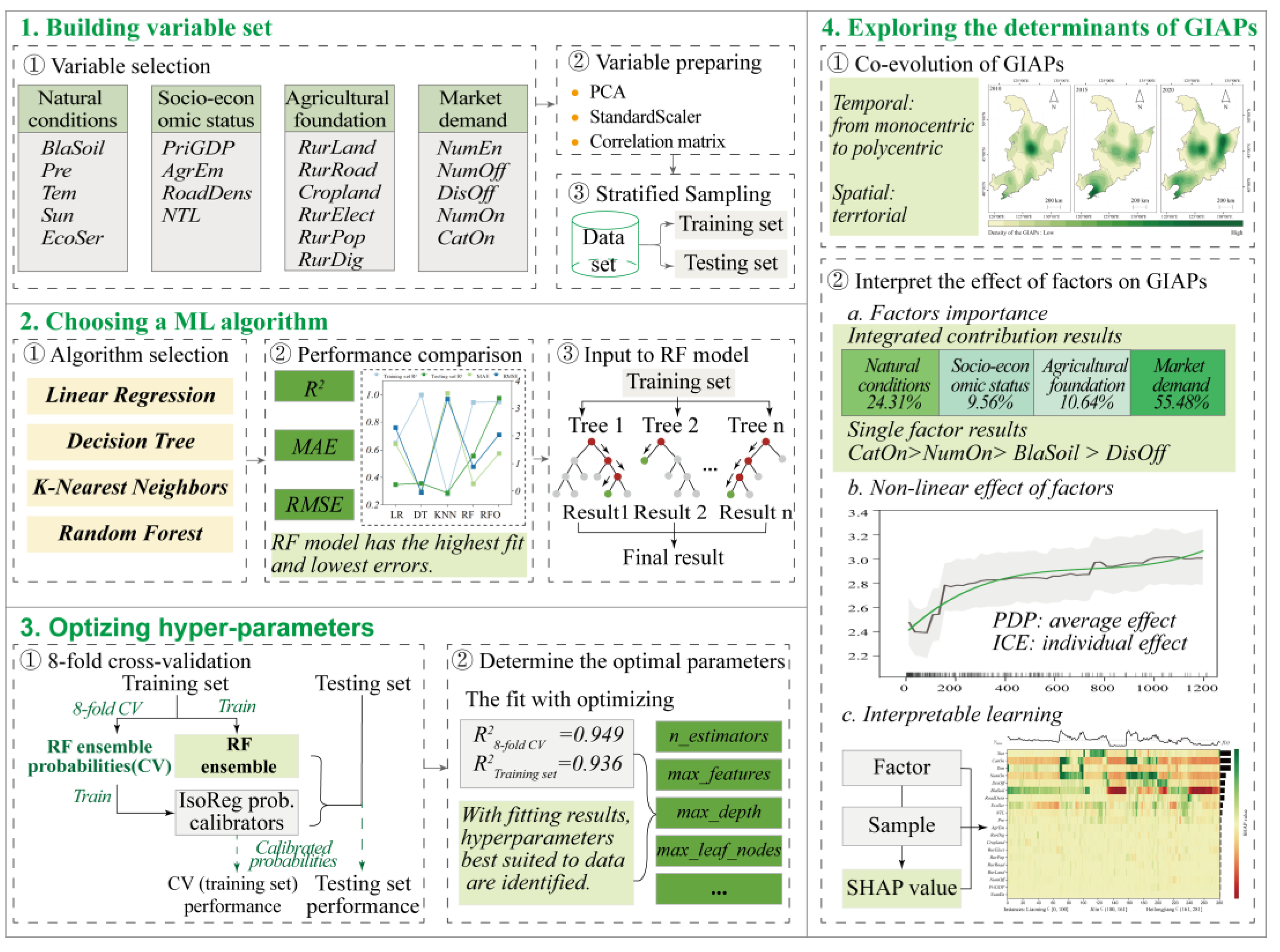

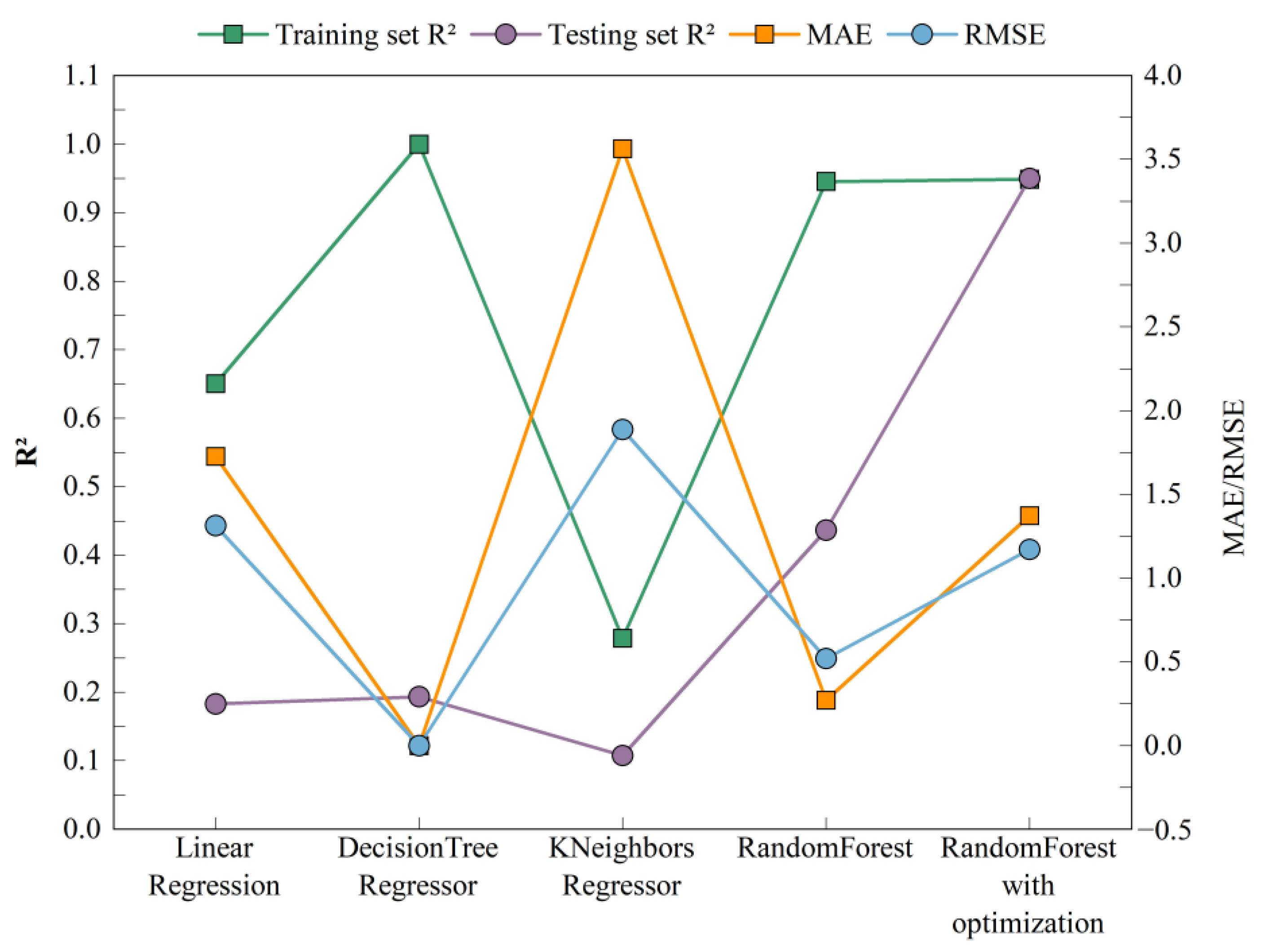

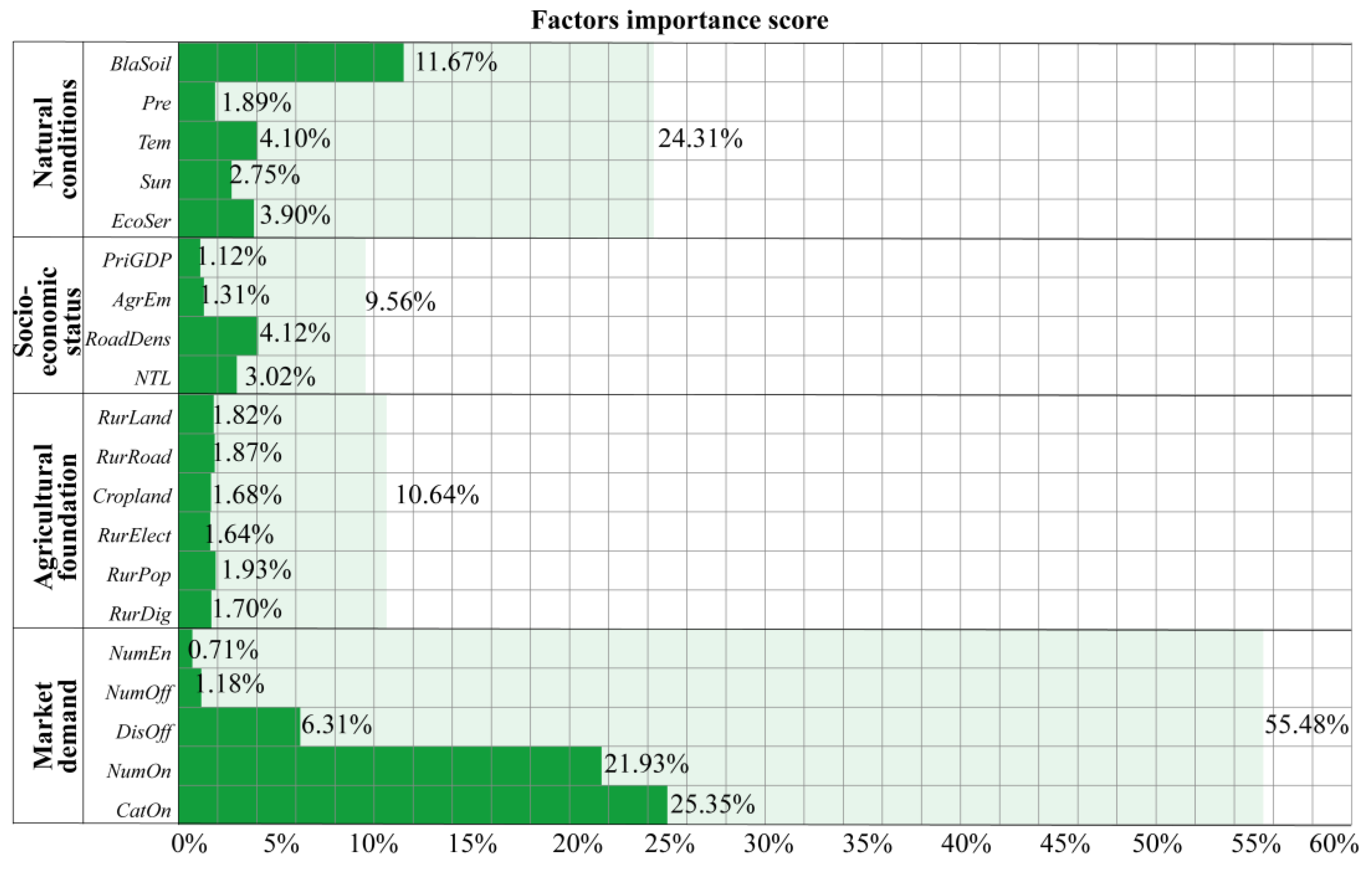
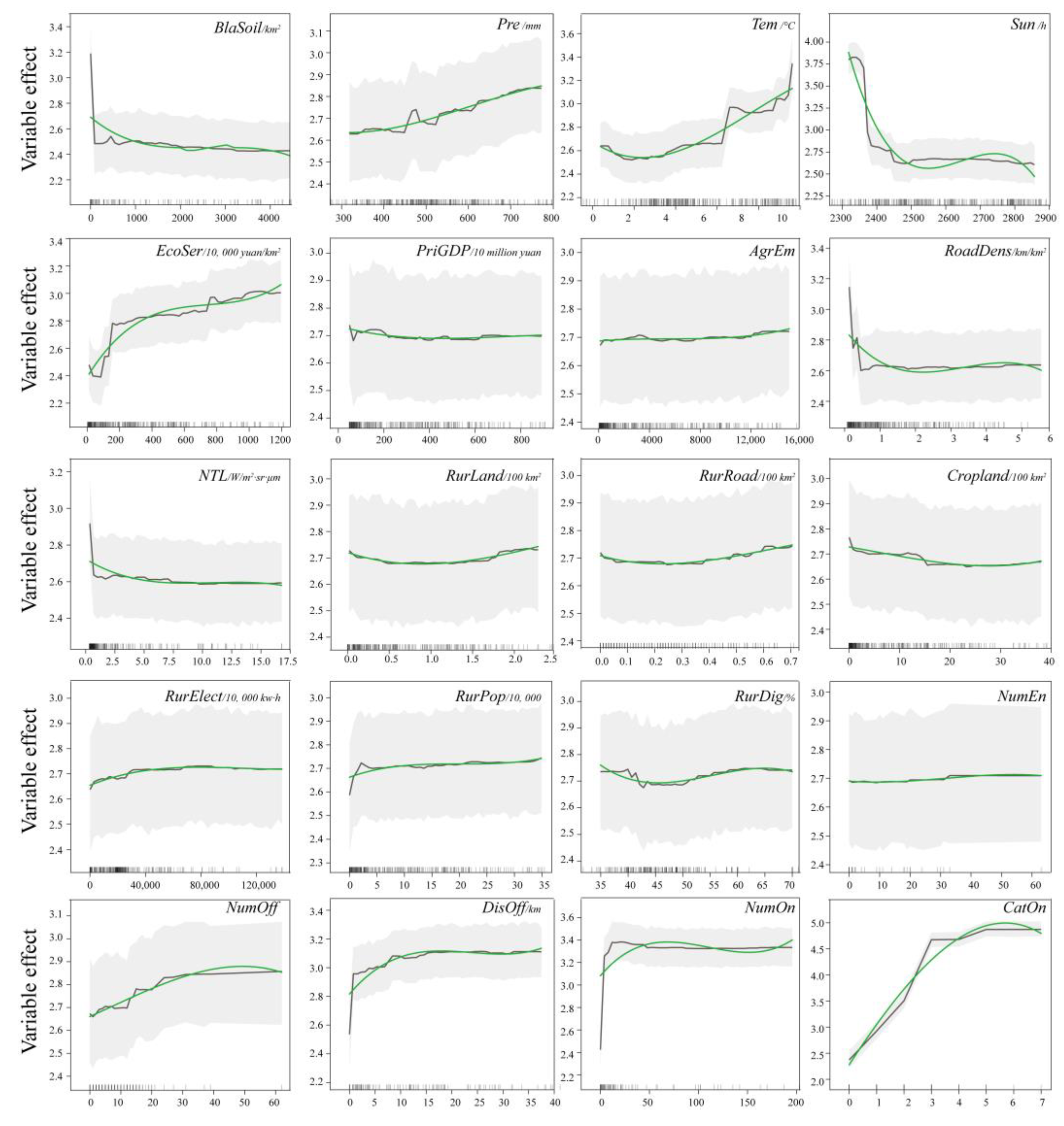

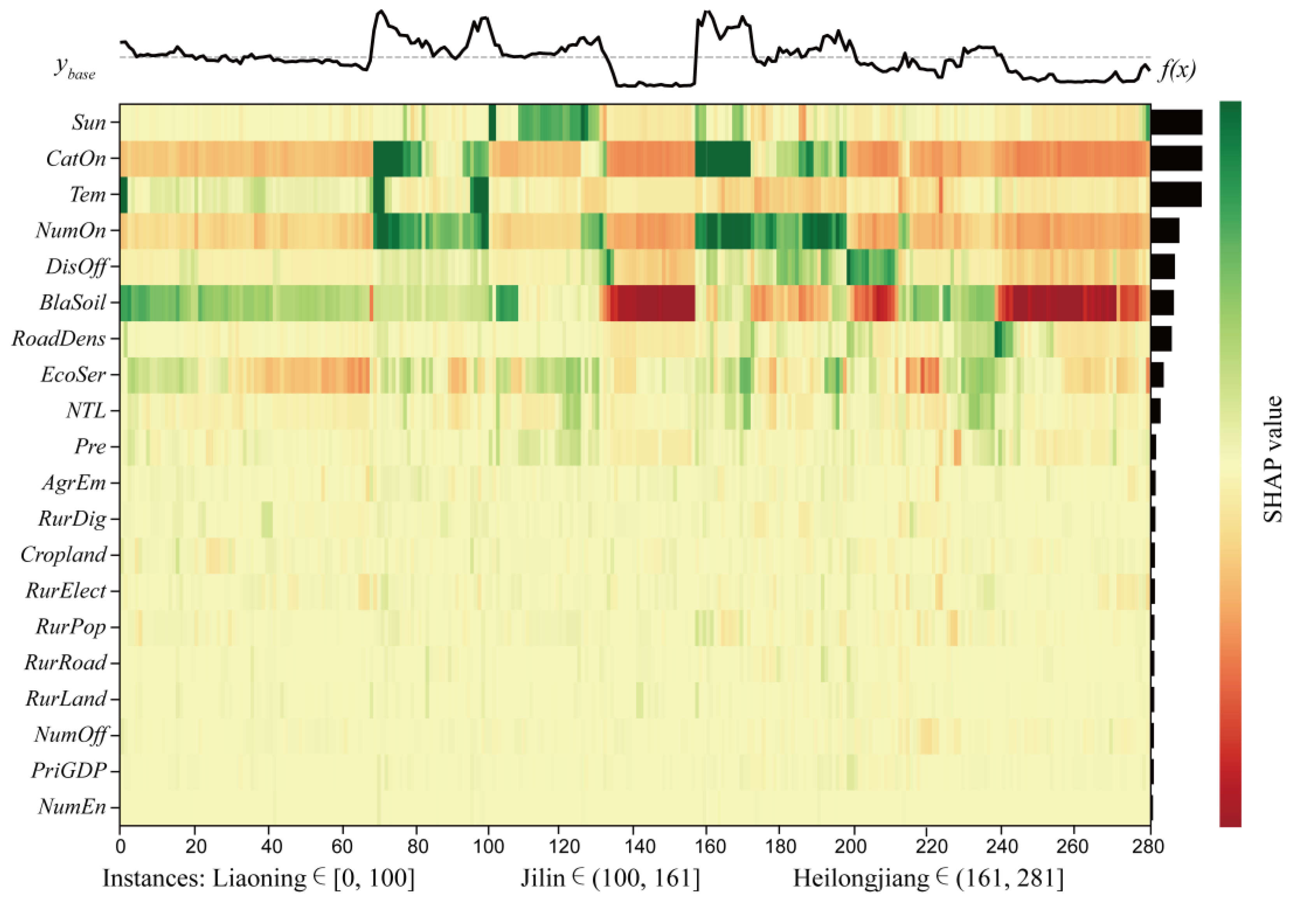
| Group | Factor | Illustrate |
|---|---|---|
| Natural conditions | BlaSoil | Area of typical black soil region in each district (km2) |
| Pre | Mean precipitation in each district (mm) | |
| Tem | Mean temperature in each district (°C) | |
| Sun | Mean sunshine duration in each district (h) | |
| EcoSer | Ecological service value in each district (10,000 yuan/km2) | |
| Socioeconomic status | PriGDP | Value-added of primary industry in each district (10 million yuan) |
| AgrEm | Number of agricultural employees in each district | |
| RoadDens | Ratio of road length to area in each district (km/km2) | |
| NTL | Mean nighttime light in each district (W/m2·sr·μm) | |
| Agricultural foundation | RurLand | Rural land area in each district (100 km2) |
| RurRoad | Rural road area in each district (100 km2) | |
| Cropland | Cropland acreage in each district (100 km2) | |
| RurElect | Rural electricity consumption in each district (10,000 kW·h) | |
| RurPop | Rural population in each district | |
| RurDig | County digital rural Index (%) | |
| Market demand | NumEn | Number of enterprises using special GI in each district |
| NumOff | Number of offline markets in each district | |
| DisOff | Distance of offline markets in each district (km) | |
| NumOn | Number of online agricultural product in each district | |
| CatOn | Category of online agricultural product in each district |
Disclaimer/Publisher’s Note: The statements, opinions and data contained in all publications are solely those of the individual author(s) and contributor(s) and not of MDPI and/or the editor(s). MDPI and/or the editor(s) disclaim responsibility for any injury to people or property resulting from any ideas, methods, instructions or products referred to in the content. |
© 2023 by the authors. Licensee MDPI, Basel, Switzerland. This article is an open access article distributed under the terms and conditions of the Creative Commons Attribution (CC BY) license (https://creativecommons.org/licenses/by/4.0/).
Share and Cite
Luo, S.; Ma, Y.; Wang, T. What Determinants Will Enhance or Constrain the Spatiality of Agricultural Products with Geographical Indications in Northeast China? An Interpretable Learning Approach. ISPRS Int. J. Geo-Inf. 2023, 12, 442. https://doi.org/10.3390/ijgi12110442
Luo S, Ma Y, Wang T. What Determinants Will Enhance or Constrain the Spatiality of Agricultural Products with Geographical Indications in Northeast China? An Interpretable Learning Approach. ISPRS International Journal of Geo-Information. 2023; 12(11):442. https://doi.org/10.3390/ijgi12110442
Chicago/Turabian StyleLuo, Siqi, Yanji Ma, and Tianli Wang. 2023. "What Determinants Will Enhance or Constrain the Spatiality of Agricultural Products with Geographical Indications in Northeast China? An Interpretable Learning Approach" ISPRS International Journal of Geo-Information 12, no. 11: 442. https://doi.org/10.3390/ijgi12110442
APA StyleLuo, S., Ma, Y., & Wang, T. (2023). What Determinants Will Enhance or Constrain the Spatiality of Agricultural Products with Geographical Indications in Northeast China? An Interpretable Learning Approach. ISPRS International Journal of Geo-Information, 12(11), 442. https://doi.org/10.3390/ijgi12110442






